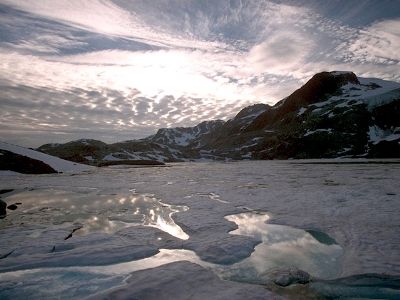February, 2008
Big Problems Deserve Great Solutions - Filling Depleted
Aquifers with Icecap Runoff
This idea may not in the end prove feasible, but along with others I am putting it out there for further consideration because, whether this suggestion or another is found to be the most practical, both aquifers running out of water and added polar or glacier ice melting and runoff, due to global warming, are considered by environmentalists to be terribly severe, long-term, perhaps crisis level concerns. Yet it is worth finding out whether one of these huge challenges just might be used to solve the other.
I believe an essential first priority for the issue of aquifers being depleted must be better water conservation and recycling methods. Nonetheless, as things stand, vastly increased demand on the world's fresh water supplies (perhaps tripled in the past 50 years) has led to over-pumping from available aquifers, particularly in China, India, and the United States. Scores of other countries have been showing signs of aquifer depletion as well. Over 3 billion people now live in countries with falling water tables.
Meanwhile, there has been much attention given to the potential difficulties from rising sea levels as glaciers and polar ice sheets melt faster than they are being naturally restored. Unchecked, the extra runoff certainly will raise sea levels, ultimately threatening many now populated and developed areas. Yet, the amount of extra melt water is finite. And the need for more water in the world's aquifers is huge. In theory, at least a substantial part of the first problem could be offset for quite some time by diverting or pumping fresh melt-water or desalinated seawater into depleted aquifers.
What are practical obstacles to such shared remedies?
First, for obvious reasons we definitely could not put saltwater into fresh water aquifers. So, unless there were major freshwater runoff sources (that could be readily diverted) near the aquifers to be filled, ocean waters would have to be utilized, for which massive desalination efforts would be required. Using only today's in-place, largely carbon fuel based technology, the energy for large-scale desalination projects would be quite costly and would in fact add to global warming.
 However, new, greener methods of generating vast energy reserves are on the horizon. And this type problem would seem to lend itself particularly well to a renewable energy source solution. It has been noted, for instance, that under Mahatma Gandhi's leadership desalination was done on a grand scale yet by cottage industry, low tech means using the sun. Both products, fresh water for farming or population centers and salt for human and animal consumption or food preservation were efficiently utilized. Indeed, since 2004 it has been reported that in India there are now efficient low tech desalination works being employed, such as one for which a single pair of oxen produce 600-700 liters of fresh water per hour. And if the need is there, as in fact it may be, water could again be desalinated over large flat areas in several parts of the world using solar power.
However, new, greener methods of generating vast energy reserves are on the horizon. And this type problem would seem to lend itself particularly well to a renewable energy source solution. It has been noted, for instance, that under Mahatma Gandhi's leadership desalination was done on a grand scale yet by cottage industry, low tech means using the sun. Both products, fresh water for farming or population centers and salt for human and animal consumption or food preservation were efficiently utilized. Indeed, since 2004 it has been reported that in India there are now efficient low tech desalination works being employed, such as one for which a single pair of oxen produce 600-700 liters of fresh water per hour. And if the need is there, as in fact it may be, water could again be desalinated over large flat areas in several parts of the world using solar power.
Second, fresh water would need to be transported from desalination areas to the aquifers where it is most required. Besides involving the world's existing river systems, themselves often very depleted or running dry, great arrays of underground or covered aqueducts could supplement the more energy intensive trucking or rail shipment of large water quantities to needed areas.
Doubtless there are other objections which could be raised. A major one, for instance, might be geopolitical. So long as each individual municipality, state, country, or region is competing with every other for scarce available fresh water resources, avoidance of extra costs, or relief from the threats of rising sea levels, it seems unlikely the will can be there for grand, comprehensive solutions to take place.
It is still possible that the profit motive alone will result in sufficient entrepreneurial or large corporate solutions. On the other hand, a necessary set of measures might turn out to involve such species-wide expenditure and heretofore uncharacteristic cooperation as to be unfeasible before great calamity were understood to be imminent.
If the problems are in fact real, it will be interesting to see how they are resolved. I would argue for reasonable and early overtures toward discovering or creating answers to these worldwide challenges. Theodore Roosevelt and Winston Churchill, in the midst of the Second World War, arguably a conflict catalyzed by great economic stress and an inequitable distribution of essential resources, came up with a workable set of principles that would govern at least the free world upon the conclusion of that great debacle. Let us hope we have the forethought this time to develop effective, mutual solutions in advance of new pressures that might otherwise bring about a still more horrific conflagration.
Source: Groundwater Depletion: A Global Problem. Leonard F. Konikow and Eloise Kendy in Hydrology Journal, Vol. 13, No. 1, pages 317-320; March, 2005.
|